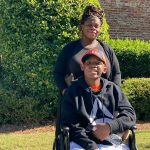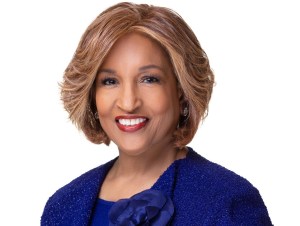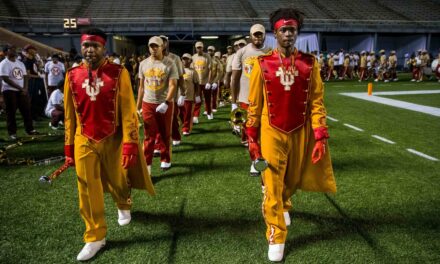By Amy Yurkanin | ayurkanin@al.com
This is another installment in Birmingham Times/AL.com joint series “Beyond the Violence: what can be done to address Birmingham’s rising homicide rate.” Sign up for the newsletter here.
When a bullet tore through the window of Patrice Leonard’s home earlier this year, hitting her teenage son Christian Savage in the face, it upended her life.
The shooting sent her son to the intensive care unit for months. She quit her job to be by his side through several surgeries and setbacks – and then the slow climb through rehab to discharge home.
For 128 days, Leonard’s life revolved around her son’s physical recovery. But the bullet disrupted other parts of her life as well.
That’s common for gun violence survivors, who often face many challenges even after they leave the hospital. Some have high medical bills, lingering physical problems and increased mental health and substance use disorders. Surgeons have gotten better at fixing the physical bullet wounds, but as Birmingham faces an unprecedented spike in gun violence, survivors say the collateral damage can be harder to repair.
“I went back to the apartment one time since it happened,” Leonard said. “When I went back into the room where it happened, I just broke down crying.”
Unexpected Obstacles
The violence forced Leonard and children out of their home in Kingston to a new place across town. Other unexpected obstacles have cropped up. The teen’s older brother has struggled with bouts of guilt, Leonard said, a nagging feeling that he should have been hurt instead of Savage.
Then there are the bills. Medicaid covers most of Savage’s medical bills, but it doesn’t pay for every prescription, Leonard said. Then there are all the other expenses from moving and missing work. The state has a fund to help victims of crime, but the application process is long and hard.
“Right now, I haven’t even filled out the packet,” Leonard said.
Although Leonard has struggled to pay for some medication not covered by Medicaid, the family is fortunate to have insurance coverage. For other survivors, medical bills can be overwhelming. Gun violence often strikes a demographic of young, low-income men who are less likely to have health insurance in Alabama, which has not expanded Medicaid.
Efforts to measure the medical costs of surviving gun violence have found the toll across the U.S. ranges from $1 billion and $2.8 billion a year. That captures initial treatment in emergency departments plus all follow up care, including related diagnoses for ongoing physical and psychological pain.
A study of medical costs from the 2017 mass shooting in Las Vegas found the injuries cost between $5,000 to $100,000 to treat. Those costs are either passed on to patients or absorbed by hospitals.
Carmone Owens, the founder of 2nd Chance Lifesavers, a Birmingham-based organization aimed at ending generational poverty by supporting at-risk youth and formerly incarcerated individuals, said many victims come in with preexisting medical deficits due to a lack of access to doctors and hospitals. After a shooting, in addition to facing medical bills, they may lack the resources for physical therapy and psychological counseling they need to recover. Lingering pain and post-traumatic stress can make some victims more violent, Owens said.
Owens said that happened to him after he was shot during an attempted robbery.
“It made me horribly more violent afterwards because I was resigned that I would never be shot again,” Owens said. “I would shoot first.”
He spent eight years in an Alabama prison where he learned about psychology and criminal thinking. Upon his release, he vowed to help young men like himself escape the cycle of violence that often begins in childhood with exposure to domestic violence or parental incarceration.
He said some people who have endured gun violence become more aggressive and less capable of handling conflict. After he was shot, Owens said he lost his sense of remorse.
‘Judged By 12’
“There’s a horrible saying: I would rather be judged by 12 than carried by six,” Owens said. “Well, I adopted that wholeheartedly.”
Owens has focused his work on addressing the psychological fallout of gun violence. Now he’s part of a movement to bring violence survivors and formerly incarcerated people into the mental health field. Depression and post-traumatic stress can cause people to become reckless and violent, he said, but young Black men who are at the highest risk for homicide are also among the least likely to seek counseling.
“Some people are suicidal, but they don’t want to kill themselves,” Owens said. “They’re living as if they don’t care if they die. And that’s an equally dangerous mindset where I’m not going to shoot myself or jump off a building, but I’m living in such a reckless manner that I don’t care if I die or not.”
People who survive gun violence also have an increased risk of being shot again. That cycle of violence has been targeted by public health researchers who are trying to develop strategies to reduce gun deaths.
The Fallout
The fallout from community violence affects people outside the perpetrator and victims. Dr. Erin Delaney, a professor in the department of family and community medicine at UAB’s Heersink School of Medicine, said she has seen an increase in patients who have been touched by gun violence at her clinic in UAB Hospital-Highlands.
“It’s every day that I’m hearing a story from a patient,” Delaney said. “In this past year, I think it’s become much more common than when I started here 10 years ago.”
Recently a young woman came in after being shot, but Delaney said she struggled to get the patient to open up about her experiences. The clinic has a psychologist on site two days a week to help patients with mental health needs, but Delaney said survivors need more resources than they can offer.
The increase in gun violence has had harmful effects on other aspects of health too, she said.
“Patients don’t exercise in their neighborhood anymore,” Delaney said. “They don’t feel safe. They’re scared. Patients don’t sleep at night because they’re scared to fall asleep because of people breaking in or maybe hearing guns in the background.”
All of that can contribute to poor cardiac health and diabetes on top of the mental health toll.
Leonard brought her son home in October. The teen, who loved basketball and dreamed of playing professionally, still has a long recovery ahead. He has learned to walk using a walker and is getting back the language he lost due to his traumatic brain injury.
Leonard said she hopes someday to see him play basketball again. Right now, he is readjusting to being at home with his siblings while attending physical, speech and occupational therapy sessions multiple times per week. But he’s come a long way from his first night at the hospital, when doctors told Leonard he might not survive.
“I tell everybody, some families don’t get this,” Leonard said. “Some families have to bury their child.”











